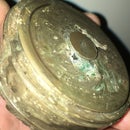Introduction: Weaving Without a Loom
This instructable has three purposes in mind - one to aid someone who is familiar in basic knitting techniques- such as finger knitting and knot weaving.
The 2nd purpose producing a useful peace of cord for a necklace, pendant, friendship band or bespoke shoelaces
The third therapy - if you are stressed or feeling less than useful - help yourself snap out of it and use your energy more constructively...:.
- Also this is a craft that does not discriminate - yes it's for men too!!! So here's to a great instructable for everyone.
Step 1: Things You May Need
Well I used A A3 Sketch Pad - A sturdy piece of card or wood will be fine.
A Clothes Peg or drawing pins
5+ different colours of embroidery thread
Scissors
Patience, Time, Music or Tranquil Surroundings
When you have all of these elements you can start.
The width of the final weave is dependent on how many pieces of Thread you start with. I started with 5 and it's roughlty 6mm in width - if you require more width calculate from this.
To start take a little of each thread out of its bundle but keep the paper retaining rings on each one. Pull out 10" on each - then tie all together with one knot.
Take this knot and place either a pin or clothes peg on the Card, wood or book to help you keep it steady as you weave. I used a sketch book as it's heavy enough and it sits on my knee without falling off.
Step 2: Weave Technique
With everything in place attach knot from bundle of threads in the centre of your choice of STEADY and place on your knee or lap and start as follows....
Fan all of your colours equally and start left to right or right to left - and try and maintain a little tension but not too much.
Take the first thread and tie a half hitch on its neighbour then proceed to the following neighbor, your tying a knot on each thread until you run out of neighbouring threads to tie to.
Next just repeat the same action - the thread your tying to needs to be straight so apply a little tension, the knot you make does not want to be too tight either.
Each time it gets a bit of length to it, it will twist up into a spiral - so to avoid getting into a pickle just move the thread up and reclamp with the peg.
If you are very confused at this point ,here's a helping hand - imaging your hand is the weave and each finger is a thread ....you're tying a knot with one colour on each finger from thumb to little finger then next colour on the left and repeat the same and so on.
The knot is a half hitch!!!!
See the sequence of the images above......and follow the purple colour
Step 3: How to Finish
The finished length is really down to final application- if it's for a friendship band then it's better to be longer than the circumference of the wrist plus half ----
For any application there are many ways of tying off and fixing both ends together - clasp - hook - Just a knot - Slip Knot - or small button. Or a popper.
I will focus on the hole for a button which you can weave into the band. When you have decided on the application or desired length the next step is fidly but not too bad.
From here split the threads up into left side and right side as my instructable uses (5 threads) this will be (3 to the left) and (2 on the right) weave (6) runs on either side - you will end up with (2) weaves strands forming, like an upside down V. See image 2......
Now to close this button hole weave using all the threads available like at the beginning, that's with (3-4) normal weave runs from left to right. Once this has been completed tie a knot and cut below the knot leaving 10mm of Thread and we are done. See other images for tying to the hole for wearing as a friendship band.
Well done for following this instructable- see next step for more detailed completion and using more threads.
Step 4: Ten Stranded Weave
Here is a version with double the number of strands that my instructable outlines. It's measures in at 10mm width, it was admittedly slightly easier to weave in the button/ tie hole but it does call for more pegs to anker the last thread as it twists to the left. -
You could place between two piece of fabric and iron to make it conform.
Please Rate & Comment IG













